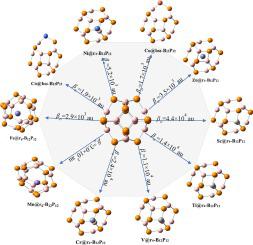Optics & Laser Technology ( IF 4.6 ) Pub Date : 2020-09-15 , DOI: 10.1016/j.optlastec.2020.106570 Sundus Irshad , Faizan Ullah , Saima Khan , Ralf Ludwig , Tariq Mahmood , Khurshid Ayub

|
Electronic as well as nonlinear optical properties (first hyperpolarizabilities) of boron phosphide nanoclusters doped with first row transition metals (Sc–Zn) are explored using density functional theory (DFT) calculations. Four different doping sites (b64, b66, r4, and r6) of the B12P12 nanocluster are considered for doping of the transition metals. Computational results revealed that these transition metals doped boron phosphide complexes are highly stable, and their HOMO–LUMO energy gaps are considerably reduced as compared to the pristine B12P12 nanocage. The highest interaction energy (−74.42 kcal mol−1) is observed for Ni@r4-B12P12 complex. The lowest HOMO–LUMO energy gap (1.44 eV) is computed for Sc@b64-B12P12 complex. Moreover, adsorption of the first row transition metals (Sc–Zn) on the surface of B12P12 nanocluster significantly enhanced the nonlinear optical response of the resultant complexes. The highest static first hyperpolarizability value (4.4 × 104 au) is computed for Sc@r4-B12P12 complex. Moreover, frequency dependent hyperpolarizability calculations are also performed to evaluate the practicality of the transition metal doped boron phosphide (M@B12P12) complexes. The highest electro-optical Pockels effect (EOPE) value of 4.4 × 105 au is computed for Sc@r4-B12P12 complex while Sc@r6-B12P12 gives the highest second harmonic generation (SHG) value of 1.1 × 105 au. This study will be advantageous for providing guidance in further designing of new high-performance nonlinear optical (NLO) materials.
中文翻译:

第一排过渡金属将磷化硼纳米簇装饰为非线性光学材料,具有高的热力学稳定性和增强的电子性能;详细的量子化学研究
使用密度泛函理论(DFT)计算探索了掺杂有第一行过渡金属(Sc-Zn)的磷化硼纳米簇的电子和非线性光学性质(第一超极化率)。B 12 P 12纳米簇的四个不同的掺杂位点(b 64, b 66, r 4和r 6)被考虑用于过渡金属的掺杂。计算结果表明,与原始B 12 P 12纳米笼相比,这些过渡金属掺杂的磷化硼配合物非常稳定,并且它们的HOMO-LUMO能隙大大减小。最高的相互作用能(−74.42 kcal mol -1观察到Ni @ r 4 -B 12 P 12配合物。计算出Sc @ b 64 -B 12 P 12络合物的最低HOMO-LUMO能隙(1.44 eV)。此外,第一行过渡金属(Sc-Zn)在B 12 P 12纳米团簇表面的吸附显着增强了所得配合物的非线性光学响应。计算Sc @ r 4 -B 12 P 12络合物的最高静态第一超极化率值(4.4×10 4 au)。此外,还进行了与频率有关的超极化率计算,以评估过渡金属掺杂的磷化硼(M @ B 12 P 12)配合物的实用性。计算Sc @ r 4 -B 12 P 12络合物的最高电光普克尔斯效应(EOPE)值为4.4×10 5 au,而Sc @ r 6 -B 12 P 12给出的最高二次谐波生成(SHG)值为1.1×10 5 au。这项研究将为进一步设计新型高性能非线性光学(NLO)材料提供指导。











































 京公网安备 11010802027423号
京公网安备 11010802027423号